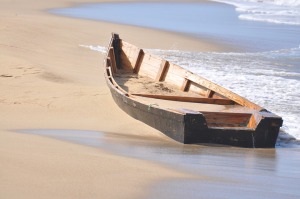
I recently came across a remarkable story of endurance and survival. It hammers home the point–made repeatedly on this site–that when disaster strikes, one must dig in and use all available resources to fight on to final victory.
The brig Polly sailed from Boston on December 12, 1811, bound for St. Croix. It was a merchant vessel, carrying lumber and preserved foods, and was captained by William Leslie Cazneau.[1] The ship displaced 130 tons and was about 70 feet in length. There were about 11 other persons on board besides the captain, two of which were passengers.
Soon after leaving New England, the ship encountered a storm and was capsized. It could not be righted, and began to drift through the Atlantic, an uncontrollable hulk completely at the mercy of the elements and the waves. Most of the provisions had been washed away when the ship upended. For provisions there was only some salt pork and a barrel of water, and these soon became dangerously depleted. The cook, an American Indian named Moho, was able to kindle a fire by rubbing two sticks together. They believed they had enough food and drink to last for about forty days, but beyond that there were no assurances.

But things would not be so easy. Caught in the Gulf Stream Drift, the inert ship was being carried to the coast of Africa. They would eventually be in international shipping lanes, but there was no way to predict when they might be spotted. Several of the survivors perished from exposure and starvation. Here and there, they managed to catch a fish or a shark, and so kept a hold on life.
The lack of water became the greatest problem. But luck and resourcefulness can be a telling combination. Someone scavenged a flintlock pistol, a pot, and an iron teakettle from the galley. Captain Cazneau inverted the pot and set the teakettle on its base. He then fashioned a wooden “collar” to connect the two implements together. This he sealed with pitch and scraps of linen. He disassembled the pistol and inserted the barrel in the spout of the teakettle. Finally, he filled the kettle with seawater and lit a fire under the pot. He was ready to distill fresh water from seawater.
He used the flint and steel from the pistol to start a fire. As the seawater boiled and steam collected in the kettle, he had his men pour cold water over the kettle to condense the steam. Fresh water began to drip out of the pistol barrel. It had worked. From this device they were able to collect about five pints of water per day. Not much, perhaps, but still able to keep them alive.
Cazneau had other ideas as well. He put the survivors to work scraping barnacles off the hull of the ship, which they either boiled or ate raw. But they were slowly losing their hold on life. Moho, the cook, died after about 90 days. The captain was able to increase his production of water after he found a second pistol on board, and added it to the distillery as a second spout.
They were visited by frustration many times. Ships would appear on the horizon or closer, and then melt away. Some even came close enough to see them; but for some reason they were never spotted. On June 12, 1812, Cazneau was able to take a reading of his location and found that he was at latitude 28 degrees North and longitude 13 degrees West, a location near the African coast. They were rescued soon after this date by a British vessel named Fame, commanded by one Captain Featherstone. They were by this time reduced to a pitiable state, as one might imagine.
The Fame eventually encountered another American ship, to which the survivors were transferred. The only remaining survivors of the ordeal were Cazneau himself and a seaman named Badger. Both of them made it back to New England to families who had long since given them up for dead. They had drifted for 191 days in total.
Leadership, discipline, and ingenuity had saved their lives.
[1] The original version of this article had the name of the captain as Andrew Cazneau. I was contacted by a descendant of the captain who pointed out that Andrew Cazneau was a cousin of the captain, whose name was William Leslie Cazneau (1768-1866).
Read More: Your Guardian Deity

You must be logged in to post a comment.